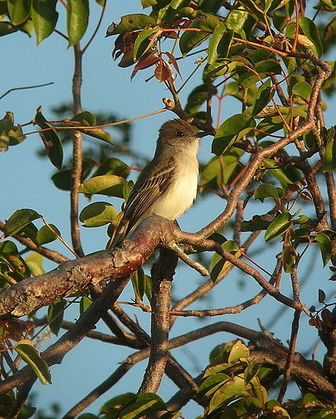Puerto rican flycatcher

Original source: TimPermission(Reusing this file)This image, which was originally posted to Flickr.com, was uploaded to Commons using Flickr upload bot on 05:34, 15 September 2008 (UTC) by Sadalmelik (talk). On that date it was licensed under the license below.This file is licensed under the Creative Commons Attribution 2.0 Generic license.You are free:to share – to copy, distribute and transmit the work
Author: TimPermission(Reusing this file)This image, which was originally posted to Flickr.com, was uploaded to Commons using Flickr upload bot on 05:34, 15 September 2008 (UTC) by Sadalmelik (talk). On that date it was licensed under the license below.This file is licensed under the Creative Commons Attribution 2.0 Generic license.You are free:to share – to copy, distribute and transmit the work
The Puerto rican flycatcher is classified as Least Concern. Does not qualify for a more at risk category. Widespread and abundant taxa are included in this category.
The Puerto Rican Flycatcher (Myiarchus antillarum) is a tyrant flycatcher endemic to the archipelago of Puerto Rico and one of the 22 species belonging to the Myiarchus genus of the Tyrannidae family. More
the Puerto Rican Flycatcher's plaintive, descending call can often be heard in wooded areas, mangroves, and coffee plantations. Its local name (juí) arises from its call, traditionally considered a harbinger of both good and bad news. Though not considered a conservation priority, a long-term study in Guánica Forest suggests that its population is in decline. Much remains to be learned about this cavity nester's social habits, mating system, and demography. More
The Puerto Rican Flycatcher is a tyrant flycatcher endemic to the archipelago of Puerto Rico – it is one of 22 species of the Myiarchus genus of the Tyrannidae family. Description: The Puerto Rican Flycatcher is approximately 7 inches (18 centimeters) long, weighing 0.8 ounces (23 grams). It has a dark-brown back and light underbody – wings occasionally show two faint buff colored bars. Habits: M. More
Woodpecker, Puerto Rican Flycatcher, Puerto Rican Vireo, Adelaide’s Warbler, Elfin-woods Warbler, Puerto Rican Tanager, Puerto Rican Spindalis, Puerto Rican Bullfinch, Yellow- shouldered Blackbird and two possible endemic species: the Lesser Antillean Pewee and the Greater Antillean Oriole. More
Puerto Rican Flycatcher, Puerto Rican Vireo, Elfin Woods Warbler, Adelaide's Warbler, Yellow-shouldered Blackbird, Puerto Rican Spindalis, Puerto Rican Tanager, and Puerto Rican Bullfinch (Note: some also consider the Puerto Rican Pewee a separate species from the Lesser Antillean Pewee). Several of these birds are critically endangered due to a number of factors. Very specific habitat requirements have led to the decline of some birds as the island has been developed. More
Family : Tyrannidae
Genus : Myiarchus
Species : antillarum
Authority : (Bryant, 1866)
